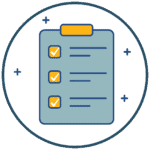Menu
PRIORITIZING CONTENT
What is the most critical learning, and how can educators support students’ access to it?
WHY
- You cannot catch up by moving at the same pace. In order to truly accelerate student learning, you must prioritize academic content, identify prerequisite skills and knowledge, and create the system-level conditions that make acceleration possible in your school(s).
- Prioritization allows educators to focus on the standards that have aspects of endurance (lasting beyond one grade or course), leverage (interdisciplinary connections), and readiness (prerequisite concepts and skills students need to enter a new grade level).
- The process of prioritizing requires educators to deeply understand the skills and concepts embedded within each standard, allowing teachers to more clearly see the learning gaps—and respond to them.


KEY TAKEAWAYS
- Priority standards are:
- What teachers will spend the majority of instructional time teaching
- What teachers will assess
- What teachers will have data-driven discussions about
- What teachers will intervene on (enrichment or remediation)
- Priority standards are those that tie across grade levels and become progressively more challenging. These are not the only things that will be taught — the supporting standards that need to be learned to reach proficiency in the priority standards must also be taught. Priority standards are the most critical things to focus on.
- Prioritizing standards does not mean lowering the bar. Prioritizing has everything to do with focus and understanding what standards have the most impact on student learning. The most important things come first. Everything else follows.
- It is important to teach the standards in an integrated way rather than in isolation. Creating ongoing opportunities for students to engage in critical thinking through priority standards that also integrate supporting standards gives an opportunity to fill in gaps. This work cannot be done unless leaders create the system-level conditions that make this possible.
- Your LEA should create a comprehensive plan that takes into consideration the unique demographics of your community. Given time and resource constraints for some LEAs, the included tips may provide a starting point for leadership teams as they roll out a full reevaluation of their scope and sequence. For a deeper dive on prioritizing standards see these CDE’s resources.
CURATED TIPS
General Considerations
- Don’t start from scratch. Leverage trusted tools, like these from Student Achievement Partners, to help prioritize learning for 2021, including Priority Instruction Content in ELA and Math.
- Detangle standards. Don’t let a non-priority standard be a gatekeeper to students’ learning. For example: if you want students to learn figurative language, think of scaffolds for the decoding and text level that may get in the way.
- Connect content. The NY State Education Department offers scaffolding that supports access to grade-level content. The Coherence Map by Achieve Partners shows the connections between common core state standards for mathematics and can help you identify what students may have missed from previous grade levels.
Tips for Prioritizing Standards in ELA
- Create a clear focus for the work. Focus on standards that represent the major work of ELA/literacy instruction: Learning to Read, Close Reading of Complex Texts, and Volume of Reading to Build Knowledge.
- Assign demanding work. Assign demanding work that helps students discover how to learn from reading and grow their knowledge, vocabulary, and understanding of syntax.
- Invest in reading time. Students should have a volume of reading to build knowledge and be exposed to academic language in the content areas. The reading needs to be at a range of complexity levels, so every student can read with minimal or no teacher support. Much of this volume should be with information-rich text, either full-length books or groups of conceptually connected shorter texts that create a cohesive topic. .
- Pay special attention to these 14 CCR standards in K-12. According to Student Achievement Partners, in grades K–12 these instructional practices are best represented by 14 CCR standards (and the research that supports them): CCSS RF.4, L.4, L.5, L.6, RI.1, RI.4, RI.9, RI.10, RL.1, RL.4, RL.10, SL.1, W.8, and W.9.19. They cross the domains of reading, writing, speaking and listening, and language.
- Learning to read trumps everything in K-3. According to Student Achievement Partners, in grades K–3, learning to read—mastering the foundational standards and the sequence of skills they point to (RF.1, RF.2, RF.3, and RF.4)—is most important.
Tips for Prioritizing Standards in Math
- Go for coherence and rigor. Ensure that prioritized standards focus on coherence and rigor.
- Focus on the major work of the grade. Student Achievement Partners have already defined where to focus by grade-level in math. This may be a helpful place to begin.
- Link together concepts within and across grades. This coherence map from Student Achievement Partners can help you identify what students may have missed from previous grade-levels.
VIDEO RESOURCES
“Prioritizing the Most Critical Prerequisite Skills and Knowledge for Each Grade Level and Subject Area”, a 27-minute video developed by the CCEE and TNTP.
Recorded 60-minute webinar of the Digital Learning Integration and Standards Guidance for English Language Arts and English Language Development (ELA/ELD) by the California Department of Education.
ADDITIONAL RESOURCES
- Collaborative for Student Success Crosswalks for adapted scope, sequence, and pacing guides by some curriculum providers.
- Subject-specific resources:
- CCEE Field Guide resources for Accelerating Learning (ELA, math, science)
- Priority Instructional Content by Student Achievement Partners (ELA and math)
- Instruction Partners’ guide for pacing
- Math-specific:
- Grades K-8 ‘Where to Focus’ documents on mathematics also by Achieve the Core
- Coherence map (mathematics)
- CDE Standards Guidance Excerpt: Section B— Standards Guidance for Mathematics (pages 101–212)
- Updated Mathematics Framework for California Public Schools: K-12
- Video California Digital Integration & Standards Guidance Webinar 2: Designing Instruction
- Reading-specific:
- Achieve the Core offers a full library of resources related to text complexity
- Student Achievement Partners Literary Text Qualitative Measures Rubric
- ELA-specific:
- General resources:
- Instruction Partners Guidance for Accelerating Student Learning
- Helping All Kids Grapple with Grade-Level Content by Achieve The Core




